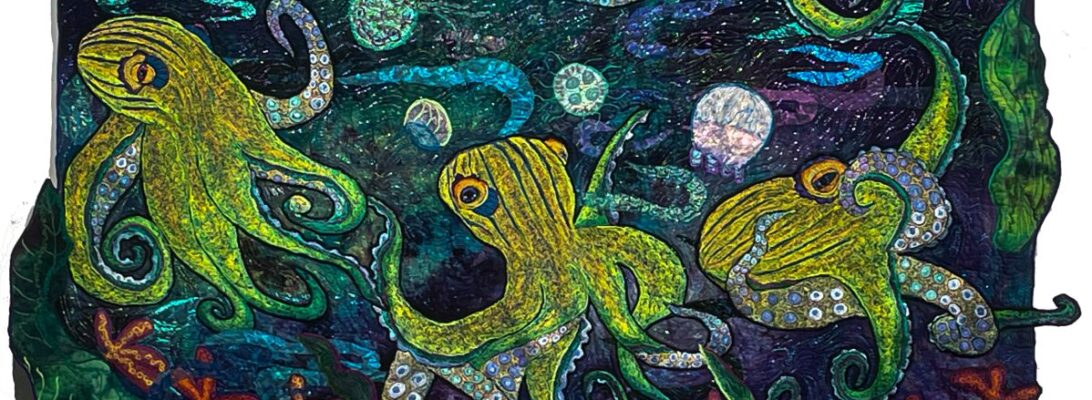
I wish I were someone who could take a design and execute it. I can try. It’s a case of man proposing, and God laughing. Instead, a series of decisions are to be made at each point. Each decision points to the next.
One of the most useful things I do in a class is to start a piece from scratch. It’s not like there is a direct list of what you do next. But there are some decisions to be made. It helps to have a plan.
Here is the list of things I need to decide for each piece.
- Background-The hand dye creates the light and the atmosphere for the piece. It usually is the first choice. Does it have a sunspot? A pool? A field of flowers within it? It dictates almost everything, especially the lighting in a piece.
- Major Images-These are the main focus. I draw them in Totally Stable, backwards. They iron on to the back of the piece and remain inside the piece as a pattern.
- Atmospherics-Water, light, smoke clouds, and sometimes leaves and flowers are atmospherics. They are usually made of commercial sheers, handpainted lace, and dyed cheesecloth. They make a translucent presence in the piece.
- Details/pathway-These are smaller embroideries, or stones, or leaves that can be used to create a visual pathway through the surface.
- Texturizing the surface/stippling- after all that embroidery, the rest of the piece needs to be integrated. The stippling over the surface can pulls the piece together.
There are no right or wrong answers. There are simply decisions. Each defines the piece. What I choose not to do also shapes the definition. I’m OK with that. I’ve learned that each decision I reject can be featured in the next piece. Or the one after that. I’m not making one perfect piece of art. I’m creating a body of art that explores the limits and range of my techniques and my skills.

This piece, like most of them, started with a piece of fabric and the idea of herons. I dye a number of pieces of fabric as cenotes, wells of color. Some times the cenotes make a light source, but this piece made a wonderful pond.


The birds started as whistling herons. But at a certain point, they were indistinguishable from the Louisiana Blues. So I did them as blue herons. It’s important to finish the major embroideries first because they shrink. You don’t know how they’ll fit in until they’re embroidered and cut out.
The atmospherics for this piece are water and grass. The grass is an oil paint stick rubbing of a ceiling tile. The water is accentuated with c-shapes of hand painted and commercial lace. Then I put in rocks to anchor the pond and direct the eye.



I decided on damsel flies and grasshoppers, as pathway elements. They did not work the way I had hoped. The damsel flies fit in, but I’m not sure of the grasshoppers. I’ll have to finish them to be sure.



Finally, I wanted seedlings growing up through the water. I made big beautiful bold seedlings the size of God’s underpants. Again, not the best choice. I scaled that down and it was much more effective, although I might want bigger ones at the bottom.
This piece is pinned in position. I’ll be stitching soon. But most of the decisions are made, step by step, before it’s stitched down.



























































